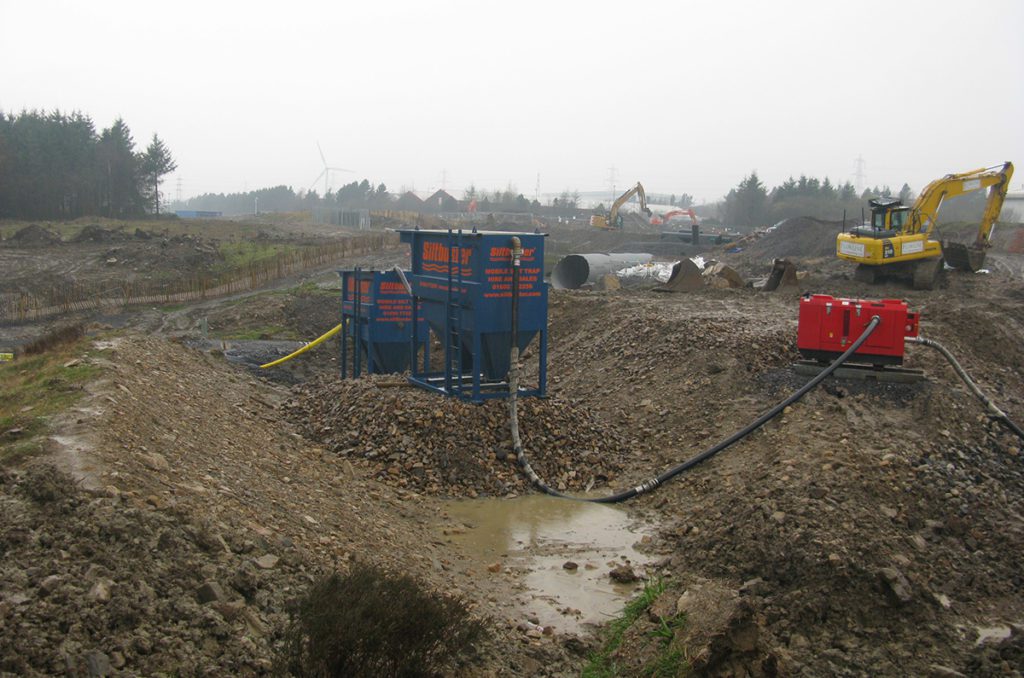
Richard D. Coulton, business unit manager (construction) at Siltbuster, outlines the typical causes of water pollution on construction sites and the solutions to treat it
IT is not uncommon for water pollution incidents to arise on construction sites, especially given the wet weather we often face in the UK. The simple act of stripping a site of topsoil or working with cement, risks contaminating water. If construction is taking place on a brownfield site, potential pollutants from groundwater and disused storage tanks, as well as mines, also present risks.
In 2018, the Environment Agency’s regulatory position statement (RPS) for the ‘Temporary Dewatering of Excavations to Surface Water’ stated that all construction firms must have a bespoke permit to discharge anything other than clean water offsite into the surrounding environment.
In addition, penalties for water pollution offences have been increasing since the introduction of the Sentencing Council’s ‘Environmental Offences: Definitive Guideline’.
In order to avoid serious fines for breaching environmental regulations, it is important that firms understand how to treat the most common sources of onsite water pollution – silty waters, oil and concrete wash water.
Suspended solids (silty water)
Due to the ease with which it can occur, silty waters account for roughly 40% of the pollution problems on construction sites.
When topsoil is stripped on a construction site, the land’s strongest defence against erosion is removed. The remaining surface has no protection from rainfall and run-off, which carries soil particles to nearby drains and watercourses. While soil is a natural substance, silty water can block the gills of fish and smother aquatic plants and invertebrates, starving them of light and oxygen.
Practical steps construction firms can take to minimise silt pollution onsite include only striping the minimum area necessary and digging cut off ditches to divert run-off from flowing so freely. However, if silty water does arise it will need dealing with, and with tankering not being a cost-efficient option, that means mastering onsite treatment techniques.
One solution is the construction of settlement lagoons. These will help with the management of suspended solids but do take up a lot of space onsite. Plus, these efforts may not work well in areas of clay geology, due to the very fine particle sizes and poor settlement characteristics.
A more compact solution is to use lamella clarifiers which are up to 20 times more space efficient than traditional baffle tanks or lagoons. If the silty waters have fine slow settling particles, such as clays, a chemical dosing stage may also be required to aggregate the particles and increase the settlement rate. Such systems can be hired or purchased to work in conjunction with existing lagoons or with portable clarifiers.
Hydrocarbons (oils)
Hydrocarbons are commonly encountered on remediation projects in the form of petroleum-based substances such as petrol, diesel, kerosene and oils. Sources can include historical spillages that have been absorbed into the land, unmapped pipe networks still full of product or even new spillages from refuelling of plant or burst hoses.
Again, there are some practical measures firms can take to minimise the damage done, such as providing oil spill kits and refuelling vehicles in designated areas where adequate spill prevention can be provided.
However, in certain cases, especially during site remediation projects, oil contaminated water may be hard to avoid and an oil water separator will be needed to remove the contamination.
A floating hydrocarbon leaves a visually obvious rainbow sheen to water, whilst a denser contaminate such as creosote will simply sink to the bottom of a tank. Both can be easily separated from water by either flotation for contaminants with a lower density than water, or settlement for contaminants with a higher density than water.
If hydrocarbons are found to be in a dissolved phase, treatment is significantly more expensive, and typically achieved by adsorbing the hydrocarbons onto activated carbon through the use of GAC vessels.
Care should be taken when working with free phase hydrocarbons as selection of the wrong sort of pump can emulsify the oils, making treatment harder and more expensive. A low sheer pump, such as a progressive cavity or diaphragm pump, is best suited to these applications.
High pH Water
The most common source of high pH water on construction sites is from the washing of concreting plant and tools, however lime stabilisation works and the re-use of crushed concrete as a recycled aggregate can also lead to an elevated pH.
Concrete wash water has a pH of between 12 and 13, which is equivalent to oven cleaner. This makes it highly damaging when discharged to the aquatic environment.
For cementitious waters, dilution isn’t a practical or cost-effective treatment method – it would take 10,000 litres of water to lower one litre of concrete wash water with a pH of 12 to an acceptable pH of eight. Mineral acids, such as sulphuric or hydrochloric acid, lower pH, but they are dangerous to handle, create secondary pollutants and are prone to overshooting the target resulting in equally polluting acidic water.
Treatment systems that incorporate carbon dioxide as a neutralising agent are cost-effective and most fit for purpose. The gas has no hazardous by-products, is easy to store and it’s virtually impossible to acidify water using it.
Conclusion
As you can see, there are some simple steps construction firms can take to both minimise the risk of creating onsite water pollution and to deal with any problems should they arise. The key lesson is to be pre-emptive rather than reactive; to anticipate the problems, prepare for the unexpected and know what the solutions are – in essence, to plan.
To help companies comply with their water treatment consent permits, Siltbuster provides technical support, CPD-accredited courses plus bespoke and tailored technical training days. Siltbuster also has an extensive range of systems to treat water pollution that can be used on projects of varying sizes.











